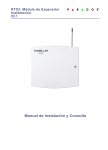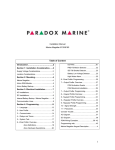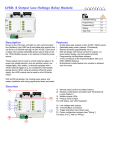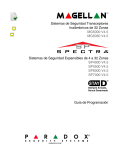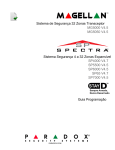Download RTX3 : Reference and Installation manual
Transcript
RTX3: Wireless Expansion Module V2.0 Reference and Installation Manual Warranty For complete warranty information, please visit www.paradox.com/terms. Your use of the Paradox product signifies your acceptance of all warranty terms and conditions. Imperial, EVO, Spectra SP Series and Esprit are trademarks or registered trademarks of Paradox Security Systems Ltd. or its affiliates in Canada, the United States and/or other countries. For the latest product approvals, such as UL and CE, please visit www.paradox.com. © 2009 Paradox Security Systems Ltd. All rights reserved. Specifications may change without prior notice. Patents One or more of the following US patents may apply: 7046142, 6215399, 6111256, 6104319, 5920259, 5886632, 5721542, 5287111, 5119069, 5077549 and RE39406 and other pending patents may apply. Canadian and international patents may also apply. Table of Contents Specifications .......................................................................... 4 Hardware Compatibility ........................................................... 4 Overview ................................................................ 5 Description .............................................................................. 5 Features .................................................................................. 5 Installation .............................................................. 7 System Reset .......................................................................... LED Feedback......................................................................... All Panels ................................................................................ EVO and SP Series only ......................................................... 7 8 8 8 Programming .......................................................... 8 Programming for Imperial ........................................................ 8 Programming for Spectra SP Series ....................................... 9 Programming for EVO ............................................................. 9 After Programming for EVO .................................................... 9 RTX3 Programming Sections for EVO .................................. 10 RTX3 PGM Options for EVO ................................................ 12 RTX3 Remote Programming for EVO - Without a K641/K641R Keypad .................................... 14 Programming for Esprit and Stand Alone .............................. 15 Esprit Programming............................................................... 15 Stand Alone Use ................................................................... 18 Firmware Upgrade................................................................. 18 Index ....................................................................19 Specifications Power input voltage: 12Vdc Frequency: 433MHz or 868MHz Sensitivity: -120 dBm Current consumption: 50 mA Dimensions (no antenna): 15cm x 16cm x 3cm (6in x 6.5in x 1.1in) Operating temperature: 0°C to 49°C (32°F to 120°F) PGM outputs: PGM1 and PGM2 - 150mA PGM transistor outputs PGM3 - form C relay output rated at 5A/28Vdc, N.O./ N.C. (PGM4 optional) Range: Refer to the appropriate transmitter Instructions Other: Di-pole antenna; Error Correction Algorithm Approvals: For the latest information on product approvals, visit our Web site at paradox.com Hardware Compatibility Zones Remotes Remote Type Wireless PGMs Wireless Keypads Wireless Siren Wireless Repeater PX8 Output Module Imperial 32 999 REM1 RAC1 REM2 RAC2 REM3 EVO 32 32/96/999 REM1 RAC1 REM2 RAC2 REM3 Spectra SP 32 32 REM1 RAC1 REM2 RAC2 REM3 Esprit 32 REM1 Stand Alone 32 32 REM1 - 8 16 - - - - 8 - - - - 4 - - - - 2 - - - - - - 4 Chapter 1: Overview Description Features The RTX3 is a 2-way, 32 zone wireless expansion module which enables Imperial, DGP/EVO, Spectra SP Series or Esprit control panels to support wireless hardware such as motion detectors and remote controls. • • Included Items: • 2 antennas Required/Optional Items: • Mounting hardware • Optional 12Vdc external power supply (PS27D / PS17) Compatibility: • Imperial V32 panels • EVO / DGP panels • Spectra SP Series panels • Esprit panels • • • • • • • • • • • Overview Up to 32 wireless zones Support for REM1 / REM2 / REM3 / RAC1 / RAC2 remote controls Support for wireless PGMs (EVO / SP Series only) Support for all Magellan transmitters including 2WPGM Support for two RPT1 and eight K32RF / K37 (SP Series only) Support for SR150 Wireless Siren and RPT1 Wireless Repeater (SP Series only) Support for PX8 Output Module In-field firmware upgradeable through WinLoad via serial or 4-wire connection RF jamming supervision Low battery, tamper and check-in supervision Transmitter signal strength display 3 PGM outputs and 1 optional output (not available on Imperial panels) Noise level test and indicator Page 5 5 1 6 2 3 7 4 8 9 1. LED display (see LED Feedback on page 8) 2. Firmware upgrade serial connection (see Firmware Upgrade on page 18) 3. Anti-tamper switch 4. PCB screw 5. Antennas 6. Mounting clips 7. Esprit Mode Programming button: Press to enter programming mode in Esprit mode (see Programming for Esprit and Stand Alone on page page 15). Also used for system reset (see System Reset on page 7). 8. Connect the Esprit 636/646 LED keypad to the “Program” connector to program in Esprit and Stand Alone mode. 9. Wiring slot Page 6 Overview Chapter 2: Installation 3 1 2 1. Control panel Combus connection NOTE: If you are using the RTX3 as a stand-alone device, connect an external 12Vdc power supply to the RED and BLK terminals. Battery backup is recommended. 2. If the current draw exceeds 150mA on PGM1 or PGM2, use a relay. Connect the RTX3’s RED connector to the relay’s RED connector, and the PGM connector (PGM1 or PGM2) to the relay’s BLK connector. 3. Connect PGM3 and PGM4 to external power supplies if you need additional power. A PS-817 is recommended. Connect the PGM’s N/O connector to the external power supply’s “+” connection. Connect the power supply’s “-” connector to the device’s “-” connector. Connect the PGM’s COM connector to the device’s “+” connector. NOTE: Write down the serial number of all wireless modules to be used with the RTX3. If this installation replaces another RTX3, make sure the programming can be transferred. System Reset The system reset feature only functions during the first 30 seconds after RTX3 power up. In order to reset the system, press and hold the Programming button for 5 seconds, the BUS RX LED flashes. Release the button and press it again while the LED flashes to reset the module to its default values. Installation Page 7 LED Feedback Legend R = Red G = Green Y = Yellow = Off = On = Flashing All Panels ERROR R Problem with the module BUS RX EVO and SP Series only ERROR R Com fail: GRN/YEL short / no data R Com fail: too many modules / wrong data BUS RX BUS TX G Receiving from panel BUS TX G Transmitting to panel RF RX G Receiving wireless RF TX Y Transmitting wireless ERROR BUS RX BUS TX G ERROR R Com fail: GRN/ BUS RX G YEL reversed BUS TX G ERROR R BUS RX Combus power too low BUS TX Chapter 3: Programming This chapter provides programming instructions for Imperial, Spectra SP Series, EVO, Esprit, and stand alone installations. Programming for Imperial When connected to an Imperial panel, all RTX3 settings are programmed using BabyWare. For more detailed instructions on using BabyWare and programming remotes, refer to the Imperial System Guide. To program an RTX3 for an Imperial system: 1. When BabyWare is communicating with the V32 controller and an RTX3 module is connected to the Multibus, it automatically appears in the Modules Page 8 Programming display area. To view the Modules display area, click the Modules toggle button. Alternatively, you may wish to add a module to BabyWare before the module is physically connected to the system. Click the Add Item button and add the RTX3 from the Zone Expansion Modules list. 2. When the RTX3 is added to the system, double-click the module’s icon. The RTX3 Programming window opens. 3. From the RTX3 Programming window, configure Input Setup and Input options. Click OK. Programming for Spectra SP Series When connected to a Spectra SP series panel, the wireless settings are programmed using control panel programming sections. Refer to the panel’s Programming Guide. NOTE: Programming for a Spectra SP series system requires K32 or K10V/H keypads version 2.0 or higher. NOTE: Only one RTX3 module can be connected to a Spectra SP Series panel. Programming for EVO When connected to an EVO panel, the wireless settings are programmed in Module Programming Mode. To enter Module Programming Mode: 1. Press and hold the [0] key. 2. Enter your [INSTALLER CODE]. 3. Enter section [4003]. 4. Enter the module’s [SERIAL NUMBER] 5. Enter the required [DATA]. NOTE: When used without a K641 or K641R keypad, enable EVO option [1] in section [3029]. After Programming for EVO Program the zones, PGMs, and remotes into the EVO panel. Refer to EVO section [3034] and RTX3 section [001]* options [2] and [3] for wireless transmitter supervision options. * For instructions on entering 3-digit RTX3 section numbers, see RTX3 Programming Sections for EVO on page 10. Programming Page 9 RTX3 Programming Sections for EVO Section Feature [001] RTX3 options Option [1] Low battery supervision Option [2] Check-in supervision Option [3] Check-in supervision time interval Option [4] RF Jamming supervision Option [5] On-board module tamper supervision Option [6] PGM1 initial state Option [7] PGM2 initial state Option [8] Transmitter tamper signal [002] Details For RTX3 version 1.5 and higher, this option is always On (default: On). default: Off Off = 24 hours (default) On = 80 minutes default: On default: Off Off On Off On Off = Normally Open (default) = Normally Closed = Normally Open (default) = Normally Closed = RTX3 ignores tamper signal (default) On = RTX3 reports tamper signal Remote control options Option [1] REM2 Visual and auditory feedback compatibility options* Off = Old visual and auditory feedback (Supported by REM2 V2.00 or lower) On = New visual and auditory feedback (default) (Requires REM2 V2.01 or higher with K641 / K641R keypads) [030] View transmitter, remote and PGM To view a transmitter’s 6-digit serial numbers serial number, press and hold the transmitter’s anti-tamper switch. * The new visual and auditory feedback includes the following system statuses: stay armed, instant armed and exit delay. Other status feedback has not changed. Note that for REM2 versions 1.04 or older, stay arm, instant arm and exit delay statuses are not supported, and a rejection beep will be heard when the system is in these statuses. Page 10 Programming Section Feature [101] to Assign wireless transmitters [132] See text Remote controls [601] to Transmitter signal strength [632] [701] to Current battery life [732] [801] to Previous battery life [832] [671] to 2WPGM signal strength [678] Programming Details [101] = Zone Input 1 [132] = Zone Input 32 Enter 6-digit serial number or press and release the transmitter’s tamper switch. To delete an assigned transmitter, enter 000000 as a serial number. To program remotes controls, refer to User Code and Remote Control Programming in the EVO Programming Guide or program remotes using WinLoad. NOTE: If programming REM1 / RAC1/ REM2 / RAC2 remotes for a system that does not include a K641/K641R keypad, enable EVO option [1] in section [3029] and refer to “RTX3 Remote Programming for EVO - Without a K641/K641R Keypad” on page 14. [601] = Zone input 1 [632] = Zone input 32 3 or less = weak (move transmitter) 4 to 10 = OK [701] = Zone input 1 [732] = Zone input 32 View number of weeks the batteries have been in the transmitter. [801] = Zone input 1 [832] = Zone input 32 View number of weeks the previous batteries were in the transmitter. [671] = PGM 1 [678] = PGM 8 3 or less = weak (move transmitter) 4 to 10 = OK Page 11 Section Feature [901] to Assign 2WPGMs [908] Details [901] = PGM 1 [908] = PGM 8 Enter 6-digit serial number or press and release the transmitter’s tamper switch. To delete an assigned 2WPGM, enter 000000 as a serial number. If a section between [901] to [904] is empty, the RTX3 will use the on-board PGM. [910] to PGM programming Program the Two-Way PGM [989] activation event, deactivation event and PGM Delay options. Refer to RTX3 PGM Options for EVO. [991] View two-way PGM tamper trouble PGM # in trouble will be displayed [992] View two-way PGM supervision PGM # in trouble will be displayed trouble RTX3 PGM Options for EVO PGM Activation PGM Number Event Group Feature Group Start # End # PGM1 [910] [911] [912] [913] PGM2 [920] [921] [922] [923] PGM3 [930] [931] [932] [933] PGM4 [940] [941] [942] [943] PGM5 [950] [951] [952] [953] PGM6 [960] [961] [962] [963] PGM7 [970] [971] [972] [973] PGM8 [980] [981] [982] [983] Default Data 000 000 000 000 NOTE: For a complete list of events, refer to the PGM programming section of your DGP/EVO control panel’s Programming Guide. Page 12 Programming PGM Deactivation PGM Number Event Group Feature Start # End Group PGM1 [914] [915] [916] [917] PGM2 [924] [925] [926] [927] PGM3 [934] [935] [936] [937] PGM4 [944] [945] [946] [947] PGM5 [954] [955] [956] [957] PGM6 [964] [965] [966] [967] PGM7 [974] [975] [976] [977] PGM8 [984] [985] [986] [987] Default Data 000 000 000 000 NOTE: For a complete list of events, refer to the PGM programming section of your Digiplex or Digiplex EVO control panel’s Programming Guide. PGM Delay PGM Number Delay Options (000 to 255) PGM1 [918] [919] PGM2 [928] [929] PGM3 [938] [939] PGM4 [948] [949] PGM5 [958] [959] PGM6 [968] [969] PGM7 [978] [979] PGM8 [988] [989] Default Data 005 Off The following options apply to sections [919], [929]... [989]: Option [1]: PGM deactivation after: See table on right Option [2]: PGM base time: On = Minutes Off = Seconds (default) [1] Off Off On On [8] Off On Off On Deactivation Event Deactivation Event PGM Timer PGM Timer or Deactivation Event Option [8]: Flexible PGM deactivation*: See table on right * In order to use the “Flexible PGM deactivation” option (option [8]), the “PGM deactivation after option” (option [1]) must be On. Programming Page 13 RTX3 Remote Programming for EVO - Without a K641/K641R Keypad Section Feature Details [040] to View or delete used [040] = remotes 1 to 8 [043] remotes [043] = remotes 25 to 32 After entering the section, select which of the eight remote positions you wish to delete. Any remote position displaying “ ” will be deleted when [ENTER] is pressed. [201] = remote 01 [201] to Assign remote [232] = remote 32 [232] controls to the Enter the desired section and then press and system hold a button on the remote control until you hear a confirmation beep. [301] to Assign remotes Assign the remote controls to users by entering a [332] controls to users user number (001 to 255) in the appropriate section (Users 001 to 255, section [301] = remote 01, section [332] = remote 32.) [401] to Program or delete remote [432] [401] = remote 01 [432] = remote 32 * _____ / _____ / _____ / _____ / _____ / _____ / _____ / _____ (default: 15000000) [0] = Button disabled [1] = Regular arm [2] = Stay arm [3] = Instant arm [4] = Force arm [5] = Disarm [6] = Stay / instant disarm [7] = Panic 1 (Police) [CLEAR] = Exit without saving Page 14 N/A + N/A N/A N/A + N/A N/A [8] = Panic 2 (non-medical) [9] = Panic 3 (fire) [STAY] = Smoke reset [FORCE] = Utility key 1 [ARM] = Utility key 2 [DISARM]= Utility key 3 [BYP] = Utility key 4 [MEM] = Utility key 5 [ENTER] = Save data Programming Programming for Esprit and Stand Alone To enter programming mode with Esprit or in Stand Alone mode: 1. Connect an Esprit 636 or 646 to the “Program” connector. 2. Press the “Esprit Mode Programming” button. 3. Press [ENTER] on your Esprit keypad and enter the installer code (default: 757575). 4. Enter the desired section number. Esprit Programming Section Feature [000] Installer code PGM initial state Option [6] PGM1 initial state Option [7] PGM2 initial state [101] to Wireless transmitter [132] assignment Details Set installer code (4 or 6 digits, default: 757575) [004] [301] to User code assignment [332] [201] to Remote control [232] assignment Programming Off = Normally open (default) On = Normally closed Off = Normally open (default) On = Normally closed [101] = Zone input 1 [132] = Zone input 32 Enter 6-digit serial number or press and release the transmitter’s tamper switch. To delete an assigned transmitter, enter 000000 as a serial number. [301] = User 01 [332] = User 32 Assign a valid user code from the Esprit Panel into the RTX3. To delete a user code, press [2ND] and then [ENTER]. [201] = Remote control 01 [232] = Remote control 32 Press [ENTER]. After the confirmation beep, press and hold any button on the remote until you hear two beeps. To delete a remote control, press [2ND] followed by [ENTER]. Page 15 Section Feature Details [401] to Remote Control Button Options [432] [401] = remote control 01 [432] = remote control 32 Option [1] Option [2] Option [3] Definition* Off Off Off No Arm or Disarm On Off Off = Regular Arm Button (default) Off On Off = Regular Arm Button On On Off Button Button Off Off On Button On Off On Button Button Off On On Button Button On On On Button = Regular Arm = Regular Arm = Force Arm = Force Arm = Stay Arm = Regular Arm = Stay Arm = Stay Arm * Buttons used to arm the system are also used to disarm the system. Option [4] To select PGM, see section [011] Option [5] To select PGM, see section [012] Option [6] To select PGM, see section [013] Option [7] To select PGM, see section [014] Option [8] Page 16 Enable button (default = On) Enable button (default = On) Enable button (default = On) Enable button (default = On) Enable button (default = On) for PGM activation for PGM activation for PGM activation for PGM activation + for Panic Alarm Programming Section Feature [011] to PGM output activation [014] [011] = Remote Button [012] = Remote Button [013] = Remote Button [014] = Remote Button Option [1] Activate PGM 1 output Option [2] Activate PGM 2 output Option [3] Activate PGM 3 output Option [4] Activate PGM 4 output [021] to PGM latch / delay [024] [021] = PGM 1 [024] = PGM 4 Option [0] Latched Option [1] 1 second Option [2] 5 seconds Option [3] 10 seconds Option [4] 20 seconds Option [5] 40 seconds Option [6] 60 seconds Option [7] 2 minutes Option [8] 4 minutes [001] Code length Option [1] Code length Option [2] Programming Panic alarm Details Refer to section [401] to [432] Default On in section [011] Default On in section [012] Default On in section [013] Default On in section [014] (default) On = 6-digit access code length (default) Off = 4-digit access code length On = Panic alarm toggles PGM and panic alarm (default) Off = Panic alarm toggles the PGM Page 17 Section Feature [002] PGM output on panic Option [0] No PGM output on panic alarm Option [1] Toggle PGM 1 on panic alarm Option [2] Toggle PGM 2 on panic alarm Option [3] Toggle PGM 3 on panic alarm Option [4] Toggle PGM 4 on panic alarm [003] RF lockout on panic Option [0] No RF signal lockout on panic alarm Option [1] 30-second RF signal lockout on panic alarm Option [2] 60-second RF signal lockout on panic alarm Option [3] 90-second RF signal lockout on panic alarm Option [4] 120-second RF signal lockout on panic alarm Details (default) (default) Stand Alone Use The RTX3 can be used as a Stand Alone module. The programming sections are the same as when used with an Esprit with the following exceptions: • In Stand Alone mode, section [001], option [1] and option [2] will not affect system use. • Panic alarms can only be used to toggle PGMs on the RTX3 in Stand Alone mode. • Sections [301] to [332] do not have to be programmed. NOTE: To program wireless transmitters in Stand Alone mode, you must use a PX8 in conjunction with the RTX3. Refer to the PX8 Instructions for more information. Firmware Upgrade The RTX3 firmware can be upgraded using either a serial connection or a fourwire connection. For firmware upgrade instructions, refer to the Firmware Upgrade Instructions document which is available at paradox.com > Software > WinLoad. To upgrade an RTX3 on an Imperial system, refer to the RTX3 chapter in the Imperial System Guide. Page 18 Programming Index Numerics 2WPGM Assigning ................................................................................ 12 Signal strength ........................................................................ 11 A Antennas .......................................................................................... 6 Anti-tamper switch ........................................................................... 6 Assign wireless transmitters .......................................................... 11 B Battery life ...................................................................................... 11 C Check-in supervision ...................................................................... 10 Check-in supervision time interval ................................................. 10 Code length ................................................................................... 17 Compatibility .................................................................................... 4 Consumption .................................................................................... 4 Current battery life ......................................................................... 11 Current consumption ........................................................................ 4 D Dimensions ...................................................................................... 4 E Esprit .............................................................................................. 15 Esprit mode ...................................................................................... 6 EVO ................................................................................................. 9 F Firmware upgrade .......................................................................... 18 Frequency ........................................................................................ 4 I Imperial ............................................................................................ 8 Input voltage .................................................................................... 4 Installation ........................................................................................ 7 Page 19 Installer code ................................................................................. 15 K K641 ................................................................................................ 9 L LED display ...................................................................................... 6 LED feedback .............................................................................. 6, 8 Low battery supervision ................................................................. 10 M Module programming mode (EVO) .................................................. 9 Mounting clips .................................................................................. 6 O On-board module tamper supervision ............................................ 10 Operating temperature ..................................................................... 4 P Panic alarm .................................................................................... 17 Patents ............................................................................................. 2 PGM Activation ................................................................................ 12 Deactivation ............................................................................ 13 Delay ...................................................................................... 13 initial state ......................................................................... 10, 15 Latch / delay ........................................................................... 17 Options for EVO ..................................................................... 12 Output activation ..................................................................... 17 output on panic ....................................................................... 18 outputs ...................................................................................... 4 Programming .......................................................................... 12 Supervision trouble ................................................................. 12 Tamper trouble ....................................................................... 12 Power input voltage ......................................................................... 4 Previous battery life ....................................................................... 11 Programming ................................................................................... 8 Programming button ........................................................................ 6 Page 20 R REM2 visual and auditory feedback .............................................. 10 Remote control assignment ........................................................... 15 Remote control button options ....................................................... 16 Remote controls ............................................................................. 11 Reset ............................................................................................... 7 RF Jamming supervision ............................................................... 10 RF lockout on panic ....................................................................... 18 S Sensitivity ......................................................................................... 4 Signal strength ............................................................................... 11 Specifications ................................................................................... 4 Spectra SP series ............................................................................ 9 Stand alone .............................................................................. 15, 18 System reset .................................................................................... 7 T Temperature .................................................................................... 4 Transmitter signal strength ............................................................ 11 Transmitter tamper signal .............................................................. 10 U User code assignment ................................................................... 15 V View serial numbers ....................................................................... 10 Voltage ............................................................................................. 4 W Warranty .......................................................................................... 2 Wireless transmitter assignment .................................................... 15 Wireless transmitter supervision options ......................................... 9 Wiring slot ........................................................................................ 6 Page 21 For technical support in Canada or the U.S., call 1-800-791-1919, Monday to Friday from 8:00 a.m. to 8:00 p.m. EST. For technical support outside Canada and the U.S., call 00-1-450-491-7444, Monday to Friday from 8:00 a.m. to 8:00 p.m. EST. Please feel free to visit our website at www.paradox.com. RTX3-EI09 07/2009 PARADOX.COM Printed in Canada
























